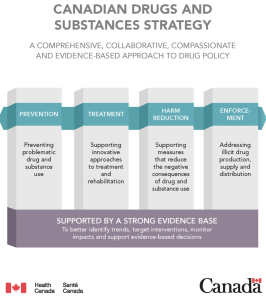5.1 Canadian Drug Policy
Canadian Drug Legislation Post-1960
1961: Narcotics Control Act (NCA)
1987: Federal/Canadian Drug Strategy (FDS/CDS)
1996: Controlled Drugs & Substances Act (CDSA)
2007: National Anti-Drug Strategy (NADS)
2012: Safe Streets and Communities Act (SSCA)
2016: Canadian Drugs & Substances Strategy (CDSS)
2017: Good Samaritan Drug Overdose Act
2018: Tobacco and Vaping Product Act (TVPA)
2018: Cannabis Act
VIDEO: Contemporary Canadian Drug Policies (1960s-Present)
The following slideshow provides an overview of contemporary Canadian drug policies from the 1960s to early 2022.
Click the links below to learn more about Canadian drug law and policy:
Quick Facts: Canada’s Drug Laws & Strategies
Cannabis in Canada: Get the Facts
Tobacco and Vaping Products Act
VIDEO: Professor Susan Boyd: An Illustrated History of Canadian Drug Policy & Prohibition
The following video provides a detailed history of Canadian drug and alcohol policy. (Start watching at 25 minute mark).
Canadian Drugs and Substances Strategy (CDSS)
Today, drug policies in Canada are informed by the Canadian Drugs and Substances Strategy (CDSS). The goal of this Strategy is protecting the health and safety of all Canadians by minimizing harms from substance use for individuals, families, and communities (CDPC, 2020b; Health Canada, 2018). There are 4 pillars of the 2016 Drug Strategy, originally introduced through the Federal Drug Strategy (1987).

Click the links below to learn more about the CDSS:
The New Canadian Drugs and Substances Strategy
Background Document: Public Consultation on Strengthening Canada’s Approach to Substance Use Issues (Read Pages 7-8)

